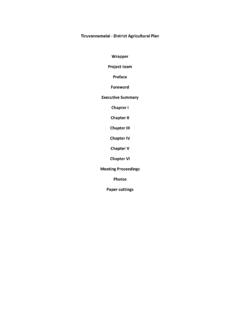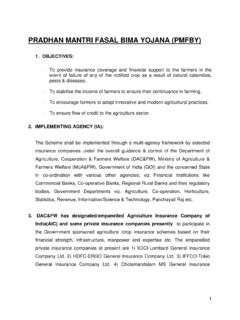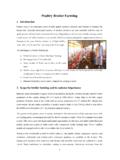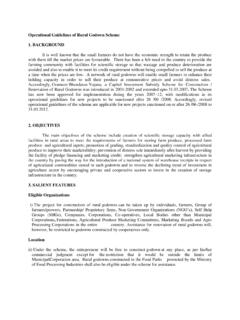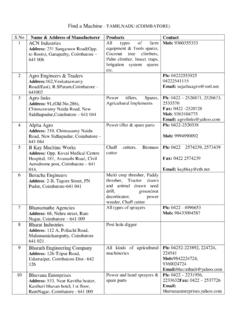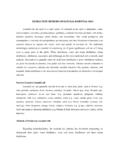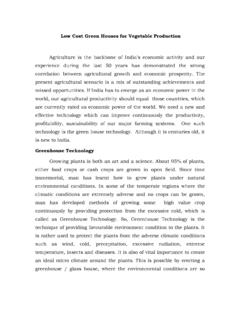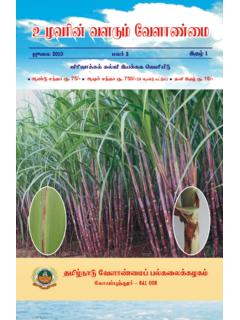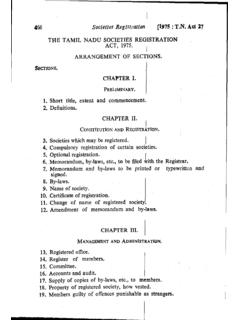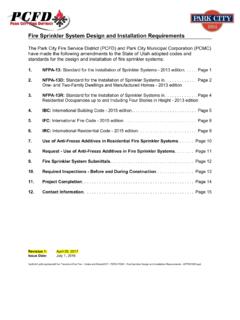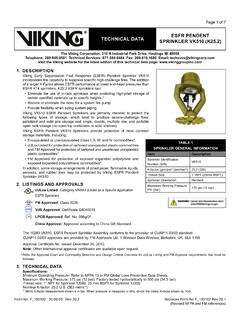Transcription of SPRINKLER IRRIGATION Introduction Advantages of …
1 SPRINKLER IRRIGATION Introduction In the SPRINKLER method of IRRIGATION , water is sprayed into the air and allowed to fall on the ground surface somewhat resembling rainfall. The spray is developed by the flow of water under pressure through small orifices or nozzles. The pressure is usually obtained by pumping. With careful selection of nozzle sizes, operating pressure and SPRINKLER spacing the amount of IRRIGATION water required to refill the crop root zone can be applied nearly uniform at the rate to suit the infiltration rate of soil. Advantages of SPRINKLER IRRIGATION Elimination of the channels for conveyance, therefore no conveyance loss Suitable to all types of soil except heavy clay Suitable for irrigating crops where the plant population per unit area is very high.
2 It is most suitable for oil seeds and other cereal and vegetable crops Water saving Closer control of water application convenient for giving light and frequent IRRIGATION and higher water application efficiency Increase in yield Mobility of system May also be used for undulating area Saves land as no bunds etc. are required Influences greater conducive micro-climate Areas located at a higher elevation than the source can be irrigated Possibility of using soluble fertilizers and chemicals Less problem of clogging of SPRINKLER nozzles due to sediment laden water Crop response to SPRINKLER The trials conducted in different parts of the country revealed water saving due to SPRINKLER system varies from 16 to 70 % over the traditional method with yield increase from 3 to 57 % in different crops and agro climatic conditions.
3 (Table .1) Response of different crops to SPRINKLER IRRIGATION Crops Water Saving, % Yield increase, % Bajra 56 19 Barley 56 16 Bhindi 28 23 Cabbage 40 3 Cauliflower 35 12 Chillies 33 24 Cotton 36 50 Cowpea 19 3 Fenugreek 29 35 Garlic 28 6 Gram 69 57 Groundnut 20 40 Jowar 55 34 Lucerne 16 27 Maize 41 36 Onion 33 23 Potato 46 4 Sunflower 33 20 Wheat 35 24 Source : INCID (1998) adapted from Table General classification of different types of SPRINKLER systems SPRINKLER systems are classified into the following two major types on the basis of the arrangement for spraying IRRIGATION water. 1. Rotating head or revolving SPRINKLER system . 2. Perforated pipe system . 1) Rotating head: Small size nozzles are placed on riser pipes fixed at uniform intervals along the length of the lateral pipe and the lateral pipes are usually laid on the ground surface.
4 They may also be mounted on posts above the crop height and rotated through 90 0, to irrigate a rectangular strip. In rotating type sprinklers, the most common device to rotate the SPRINKLER heads is with a small hammer activated by the thrust of water striking against a vane connected to it. Fig .1 Example of a few rotating type SPRINKLER IRRIGATION systems 2) Perforated pipe system : This method consists of drilled holes or nozzles along their length through which water is sprayed under pressure. This system is usually designed for relatively low pressure (1 kg/cm2). The application rate ranges from to 5 cm per hour for various pressure and spacing. Based on the portability, SPRINKLER systems are classified into the following types: (i) Portable system : A portable system has portable main lines, laterals and pumping plant Fig.
5 2 Fully portable SPRINKLER IRRIGATION system Side roll (ii) Semi portable system : A semi portable system is similar to a portable system except that the location of water source and pumping plant is fixed. (iii) Semi permanent system : A semi permanent system has portable lateral lines, permanent main lines and sub mains and a stationery water source and pumping plant. (iv) Solid set system : A solid set system has enough laterals to eliminate their movement. The laterals are positions in the field early in the crop season and remain for the season. (v) Permanent system : A fully permanent system consists of permanently laid mains, sub mains and laterals and a stationery water source and pumping plant.
6 Components of SPRINKLER IRRIGATION system The components of portable SPRINKLER system are shown through fig .3. A SPRINKLER system usually consists of the following components (i) A pump unit (ii) Tubings- main/submains and laterals (iii) Couplers (iv) Sprinker head (v) Other accessories such as valves, bends, plugs and risers. Fig .3 Component of a portable SPRINKLER IRRIGATION system (i) Pumping Unit: SPRINKLER IRRIGATION systems distribute water by spraying it over the fields. The water is pumped under pressure to the fields. The pressure forces the water through sprinklers or through perforations or nozzles in pipelines and then forms a spray. A high speed centrifugal or turbine pump can be used for operating SPRINKLER IRRIGATION for individual fields.
7 Centrifugal pump is used when the distance from the pump inlet to the water surface is less than eight meters. For pumping water from deep wells or more than eight meters, a turbine pump is suggested. The driving unit may be either an electric motor or an internal combustion engine. (ii) Tubings: Mains/submains and laterals: The tubings consist of mainline, submanins and laterals. Main line conveys water from the source and distributes it to the submains. The submains convey water to the laterals which in turn supply water to the sprinklers. Aluminum or PVC pipes are generally used for portable systems, while steel pipes are usually used for center-pivot laterals. Asbestos, cement, PVC and wrapped steel are usually used for buried laterals and main lines.
8 (iii) Couplers: Couplers are used for connecting two pipes and uncoupling quickly and easily. Essentially a coupler should provide (a) a reuse and flexible connection (b) not leak at the joint (c) be simple and easy to couple and uncouple (d) be light, non-corrosive, durable. (iv) SPRINKLER Head: SPRINKLER head distribute water uniformly over the field without runoff or excessive loss due to deep percolation. Different types of sprinklers are available. They are either rotating or fixed type. The rotating type can be adapted for a wide range of application rates and spacing. They are effective with pressure of about 10 to 70 m head at the SPRINKLER . Pressures ranging from 16 to 40 m head are considered the most practical for most farmers.
9 SPRINKLER head Fixed head sprinklers are commonly used to irrigate small lawns and gardens. Perforated lateral lines are sometimes used as sprinklers. They require less pressure than rotating sprinklers. They release more water per unit area than rotating sprinklers. Hence fixed head sprinklers are adaptable for soils with high intake rate. (v) Fittings and accessories: The following are some of the important fittings and accessories used in SPRINKLER system . (a) Water meters: It is used to measure the volume of water delivered. This is necessary to operate the system to give the required quantity of water. (b) Flange, couplings and nipple used for proper connection to the pump, suction and delivery.
10 (c) Pressure gauge: It is necessary to know whether the SPRINKLER system is working with desired pressure to ensure application uniformity. (d) Bend, tees, reducers, elbows, hydrants, butterfly valve and plugs. (e) Fertilizer applicator: Soluble chemical fertilizers can be injected into the SPRINKLER system and applied to the crop. The equipment for fertiliser application is relatively cheap and simple and can be fabricated locally. The fertilizer applicator consists of a sealed fertilizer tank with necessary tubings and connections. A venturi injector can be arranged in the main line, which creates the differential pressure suction and allows the fertilizer solution to flow in the main water line. Fig Different SPRINKLER pipes and fittings QRC HDPE SPRINKLER with metal latches QRC HDPE SPRINKLER with plastic latches QRC HDPE SPRINKLER base QRC HDPE pump connector QRC HDPE bend QRC HDPE tee QRC HDPE end plug General rules for SPRINKLER system design Main should be laid up and down hill Lateral should be laid across the slope or nearly on the contour For multiple lateral operation.
